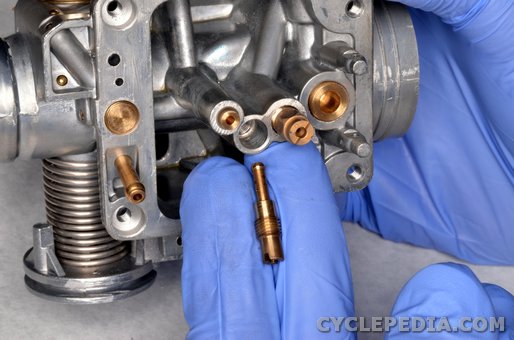Mikuni Bs34 Carburetor Manual
The Mikuni BS32SS carburetor had a 1.3-inch bore size, with a standard idle rpm of 1,150, plus or minus 100 rpm. The fuel level measured at 0.2 inch, plus or minus 0.02 inch, and the float height measured 0.88 inch, plus or minus 0.04 inches. The main air jet measured 1.7 millimeters. The by-pass measured 0.8 millimeter and the pilot outlet measured 0.7 millimeter. The valve seat measured 2 millimeters. The recommended cable play for both the throttle cable and choke cable measured 0.5 to 1 millimeter, or 0.02 to 0.04 inches. The Mikuni carburetor was designed to meet the 1980 United States Federal Emission Regulations.
Any motorcycle having over 50 cubic centimeters of engine displacement was required to adhere to this emissions level. This called for a hydrocarbon level no greater than 8 grams per mile and a carbon monoxide level no greater than 19.3 grams per mile. The main jet, needle jet and pilot jet were all components specifically calibrated to allow the Mikuni BS32SS to meet the required emission level requirements.
Cr500 crm middleware pdf download pdf. According to Suzuki, if the air cleaner fails in the Mikuni BS32SS carburetor, it could be due to the presence of dirt or excess oil lubrication. A faulty fuel level in the carburetor could be caused by a sticking float, a leaking needle or an incorrect carburetor setting. A leaking or sticking linkage could cause the choke to malfunction.
Clogged or restricted carburetor jets, a too lean or too rich float level, leaking choke plunger or sticking linkage, or air leaks in the intake manifolds or engine gaskets could all cause mixture malfunctions in the carburetion system.

Laws when installed according to instructions. 1990 to 1998 1340 Big Twin Evolution models sold in California. Includes 42mm. Mikuni Bs34 Carburetor Manual - Looking at some Mikuni BS34 Carbs and parts Miko Zen. How to Disassemble and Clean a Mikuni Carburetor - DIY Snowmobile, Mower.Mikuni BS (CV) Carburetor Rebuild Tutorial Remove pilot jet plug (replace if petrified) The pilot jet is located down in the recess tunnel under the plug.Carburetor.
Crestron master installer download. I have an '81 Yamaha XS400 with dual Mikuni BS34 carbs. I cleaned the carbs once before, but then could never get it to idle right. Had to play with the choke to get it to idle normally, which I didn't want to try to fiddle with while riding. So I'm at it again: On the top of the carb where the diaphragm is, there is one hole for the choke, and another hole for.?
Mine were plugged up with crap, and I got some of it out to the point where I can see shiny brass a little ways down. Are these holes supposed to flow air or fuel, meaning I should continue my cleaning attempts, or is this just a hole leftover from the casting/assembly process? If it's supposed to flow something, why do I see brass a short ways down the hole? FOG 17/3/2007, 16:50 น.
On 17 Mar 2007 14:46:35 -0700, Suggest you do some searching on the Mikuni USA website. There's a.pdf manual there for their normal carbs, may also be one for CVs. -- Ivan Reid, School of Engineering & Design, _____________ CMS Collaboration, Brunel University. Ivan.Reid@[ ] Room 40-1-B12, CERN GSX600F, RG250WD 'You Porsche.
DoD #484 JKLO#003, 005 WP7# 3000 LC Unit #2368 (tinlc) UKMC#00009 BOTAFOT#16 UKRMMA#7 (Hon) KotPT -- 'for stupidity above and beyond the call of duty'. Germaine 18/3/2007, 8:22 น. On Mar 17, 1:46?pm, wrote: > On the top of the carb where the diaphragm is, there is one hole for > the choke, and another hole for.? Mine were plugged up with > crap, and I got some of it out to the point where I can see shiny > brass a little ways down. Are these holes supposed to flow air or > fuel, meaning I should continue my cleaning attempts, or is this just > a hole leftover from the casting/assembly process?
If it's supposed to > flow something, why do I see brass a short ways down the hole? Because it's the non-removable PILOT AIR JET. When you have a CV carburetor that has the idle mixture screws on top, you're usually going to find the pilot air jet under the diaphragm. It regulates the flow of air through a fixed orifice.

The carb sucks gasoline up through the pilot or idle jet in the float bowl and the fuel and air mix high up in the carburetor. The idle mixture screws just control one of four idle mixture ports, the other three ports are fixed transition ports that allow the engine to get extra gasoline while vacuum drops off slightly as you just barely open the throttle. Transition ports are the CV carburetor's equivalent of the accelerator pump that a car carburetor has. You need to have all the idle passages open and all four ports clean or you'll have to run on the 'choke'. Why can't you get the engine to idle right without using the 'choke'?
Your carbs don't have a 'choke', they have a starting enrichener device, which is like a tiny carburetor built into the side of each main carburetor. When you pull on the 'choke' knob, you're opening an air valve and the vacuum downstream of the throttle butterfly sucks gasoline up a small diameter passage like a kid sucking milk through a straw. It's a very rich mixture, but that's what your engine needs to start when it's cold. So, your idle jets, idle ports, and idle passages are all plugged up.